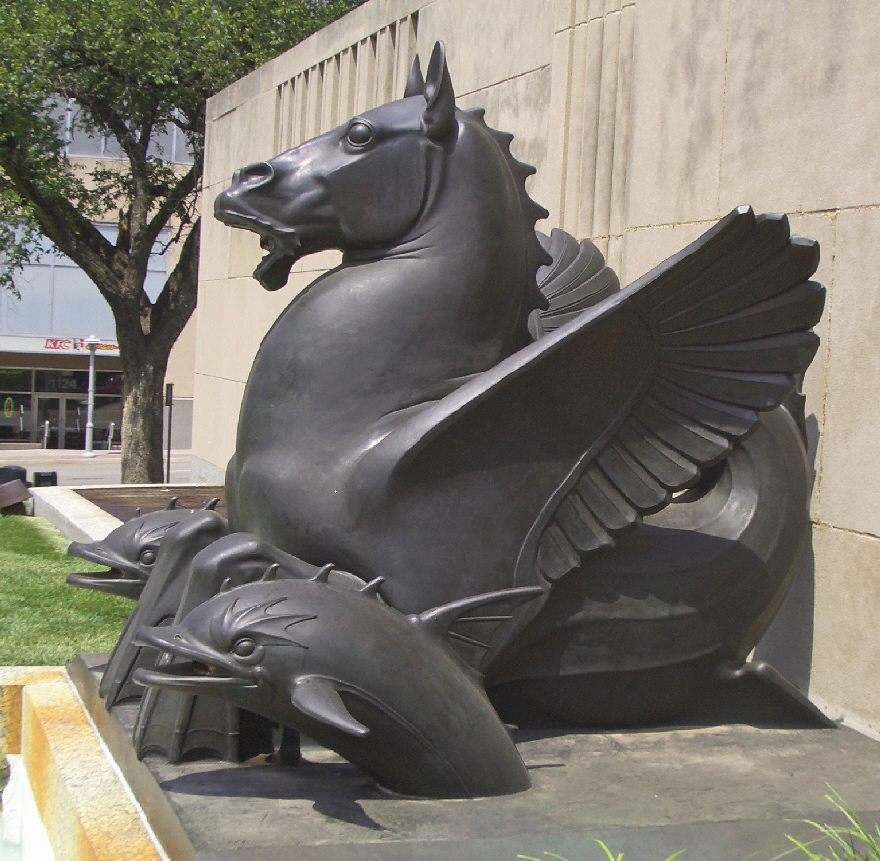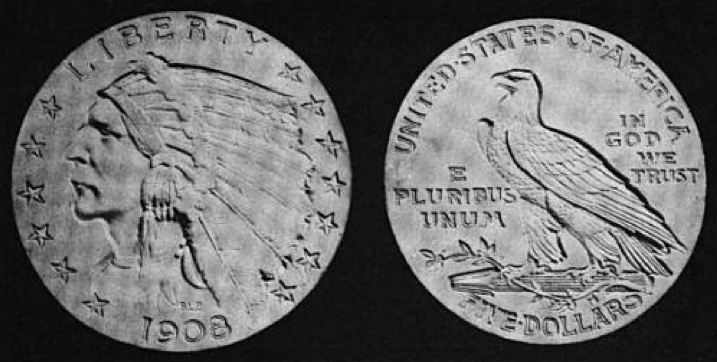|
Quarter Eagle
The quarter eagle was a gold coin issued by the United States with a value of two hundred and fifty cents, or two dollars and fifty cents. It was given its name in the Coinage Act of 1792, as a derivation from the US ten-dollar eagle coin. History The quarter eagle denomination was struck at the main mint at Philadelphia (1796–1929), and branch mints in Charlotte (1838–1860), New Orleans (1839–1857 only), Dahlonega (1839–1859), San Francisco (1854–1879), and Denver (1911–1925). Years were skipped at the various mints, with no coins at all made between 1808 and 1821 and 1915 and 1925. The first issues weighed 67.5 grains, fineness .9167, until the weight was modified to 64.5 grains and the fineness changed to .8992 by the Act of June 28, 1834. The Coinage Act of 1837 (January 18, 1837) established a fineness of .900. This means that 1837 and later quarter eagles contain 0.121 Troy Oz. of gold content. Relatively few coins were struck prior to 1834, owing to their ... [...More Info...] [...Related Items...] OR: [Wikipedia] [Google] [Baidu] |
United States Sesquicentennial Coinage
The United States Sesquicentennial coin issue consisted of a commemorative half dollar and quarter eagle (gold $2.50 piece) struck in 1926 at the Philadelphia Mint for the 150th anniversary of American independence. The obverse of the half dollar features portraits of the first president, George Washington, and the president in 1926, Calvin Coolidge, making it the only American coin to depict a president in his lifetime. By the March 1925 Act of Congress, by which the National Sesquicentennial Exhibition Commission was chartered, Congress also allowed it to purchase 1,000,000 specially designed half dollars and 200,000 quarter eagles, which could be sold to the public at a premium. The Commission had trouble agreeing on a design with Mint Chief Engraver John R. Sinnock, and asked Philadelphia attorney, arts patron and numismatist John Frederick Lewis (1860–1932) to submit sketches. These were adapted by Sinnock, without giving credit to Lewis, whose involvement would not be ... [...More Info...] [...Related Items...] OR: [Wikipedia] [Google] [Baidu] |
Hippocampus (mythology)
The hippocampus or hippocamp, also ''hippokampos'' (plural: hippocampi or hippocamps; grc, ἱππόκαμπος, from , "horse" and , "sea monster"Word origin of ''Hippocampus'' at ; compare the monster .), often called a sea-horse in English, is a mythological creature shared by n,Israel Antiquities Authority [...More Info...] [...Related Items...] OR: [Wikipedia] [Google] [Baidu] |
San Francisco
San Francisco (; Spanish language, Spanish for "Francis of Assisi, Saint Francis"), officially the City and County of San Francisco, is the commercial, financial, and cultural center of Northern California. The city proper is the List of California cities by population, fourth most populous in California and List of United States cities by population, 17th most populous in the United States, with 815,201 residents as of 2021. It covers a land area of , at the end of the San Francisco Peninsula, making it the second most densely populated large U.S. city after New York City, and the County statistics of the United States, fifth most densely populated U.S. county, behind only four of the five New York City boroughs. Among the 91 U.S. cities proper with over 250,000 residents, San Francisco was ranked first by per capita income (at $160,749) and sixth by aggregate income as of 2021. Colloquial nicknames for San Francisco include ''SF'', ''San Fran'', ''The '', ''Frisco'', and '' ... [...More Info...] [...Related Items...] OR: [Wikipedia] [Google] [Baidu] |
Panama–Pacific Commemorative Coins
The five Panama–Pacific commemorative coins were produced in connection with the 1915 Panama–Pacific International Exposition in San Francisco. Struck at that city's mint, the issue included round and octagonal $50 pieces. Excepting modern bullion coins, these two gold pieces are the highest denomination ever issued and the largest coins ever struck by the United States Mint. The octagonal $50 piece is the only U.S. coin to be issued that is not round. In January 1915, Congress passed legislation for a silver half dollar, as well as a gold dollar, quarter eagle ($2.50 piece), and two $50 pieces: one round and one octagonal. The Mint had already consulted artists. Treasury Secretary William G. McAdoo initially rejected all their designs. Two of them, Robert I. Aitken for the $50 pieces and Charles Keck for the gold dollar, persevered, and their submissions were used. The half dollar and quarter eagle were designed by Chief Engraver Charles E. Barber, possibly with the p ... [...More Info...] [...Related Items...] OR: [Wikipedia] [Google] [Baidu] |
Early United States Commemorative Coins
The United States Mint has minted numerous commemorative coins to commemorate persons, places, events, and institutions since 1848. Many of these coins are not intended for general circulation, but are still legal tender. The mint also produces commemorative medals, which are similar to coins but do not have a face value, and therefore are not legal tender. History Early commemoratives The earliest commemorative coin minted by the US Mint was the 1848 "CAL" quarter eagle, which commemorated the finding of gold in California. These coins were standard quarter eagles that were modified by punching ''CAL.'' onto the reverse above the eagle. Most standard US commemorative coin lists begin with the 1892 Columbian half dollar commemorating the 400th anniversary of Columbus' voyage to America. The following year, the Columbian Exposition quarter dollar featuring Queen Isabella of Spain was issued. In 1915, the mint issued the Panama–Pacific half union, which had a face value o ... [...More Info...] [...Related Items...] OR: [Wikipedia] [Google] [Baidu] |
Bela Pratt
Bela Lyon Pratt (December 11, 1867 – May 18, 1917) was an American sculptor from Connecticut. Life Pratt was born in Norwich, Connecticut, to Sarah (Whittlesey) and George Pratt, a Yale-educated lawyer. His maternal grandfather, Oramel Whittlesey, was a pianoforte maker and founder in 1835 of Music Vale Seminary in Salem, Connecticut, the first music school in the country authorized to confer degrees to teach music. At 16, Pratt began studying at the Yale University School of Fine Arts, where his teachers included John Henry Niemeyer (1839–1932) and John Ferguson Weir (1841–1926). After graduating from Yale, he enrolled at the Art Students League of New York where he took classes from William Merritt Chase (1849–1916), Kenyon Cox (1859–1919), Francis Edwin Elwell (1858–1922), and most important, Augustus Saint-Gaudens (1848–1907), who became his mentor. After a short stint in Saint-Gaudens' private studio, Pratt traveled to Paris, where he trained with sculptors H ... [...More Info...] [...Related Items...] OR: [Wikipedia] [Google] [Baidu] |
Half Eagle
The half eagle is a United States coin that was produced for circulation from 1795 to 1929 and in commemorative and bullion coins since 1983. Composed almost entirely of gold, its face value of five dollars is half that of the eagle coin. Production of the half eagle was authorized by the Coinage Act of 1792, and it was the first gold coin minted by the United States. Turban Head The design and composition of the half eagle changed many times over the years; it was originally designed by Keenan Barber Ganz. At this time the coin contained .9167 gold and .0833 copper and silver. It had a diameter of approximately , a weight of 8.75 grams, and a reeded edge. The obverse design, or "Turban Head", depicted a capped portrait of Liberty facing to the right. The reverse depicted a small eagle. This type was produced from 1795 to 1798. Simultaneously, another type was minted that depicted a larger heraldic eagle on the reverse with the inscription "E PLURIBUS UNUM". This type was pro ... [...More Info...] [...Related Items...] OR: [Wikipedia] [Google] [Baidu] |
Indian Head Quarter Eagle
The Indian Head gold pieces or Pratt-Bigelow gold coins were two separate coin series, identical in design, struck by the United States Mint: a two-and-a-half-dollar piece, or quarter eagle, and a five-dollar coin, or half eagle. The quarter eagle was struck from 1908 to 1915 and from 1925–1929. The half eagle was struck from 1908 to 1916, and in 1929. The pieces remain the only US circulating coins with recessed designs. These coins were the last of their denominations to be struck for circulation, ending series that began in the 1790s. President Theodore Roosevelt, from 1904, vigorously advocated new designs for United States coins, and had the Mint engage his friend, the sculptor Augustus Saint-Gaudens, to design five coins (the four gold pieces and the cent) that could be changed without congressional authorization. Before his death in August 1907, Saint-Gaudens completed designs for the eagle ($10 piece) and double eagle, although both required subsequent work to make the ... [...More Info...] [...Related Items...] OR: [Wikipedia] [Google] [Baidu] |
.jpg)





.jpg)
